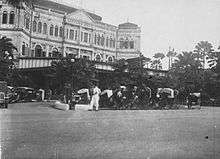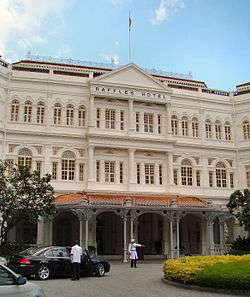Raffles Hotel
| Raffles Hotel | |
|---|---|
|
Raffles Hotel Singapore | |
 Location within Singapore | |
| General information | |
| Location | 1 Beach Road, Singapore 189673 |
| Opening | 1887 |
| Management | Fairmont Raffles Hotels International |
| Technical details | |
| Floor count | 3 |
| Design and construction | |
| Architect | Regent Alfred John Bidwell |
| Developer | Sarkies Brothers |
| Other information | |
| Number of rooms | 103 |
| Number of suites | 103 |
| Number of restaurants | 8 |
| Website | |
| www.raffles.com/singapore | |
Raffles Hotel is a colonial-style luxury hotel in Singapore. It was established by Armenian hoteliers, the Sarkies Brothers, in 1887. The hotel was named after British statesman Sir Thomas Stamford Raffles, the founder of Singapore. It is the flagship property of Raffles Hotels & Resorts, a subsidiary of Fairmont Raffles Hotels International.
History
Raffles Hotel Singapore started as a privately owned beach house built in the early 1830s. It first became Emmerson's Hotel when Dr. Charles Emmerson leased the building in 1878. Upon his death in 1883, the hotel closed, and the Raffles Institution stepped in to use the building as a boarding house until Dr. Emmerson's lease expired in September 1887.[1]
Almost immediately after the first lease expired, the Sarkies Brothers leased the property with the intention of turning it into a high-end hotel. Just a few months later, on December 1, 1887, the ten-room Raffles Hotel opened. Its proximity to the beach, and its reputation for high standards in services and accommodations made the hotel popular with wealthy clientele.[1]
Within the hotel's first decade, three new buildings were added on to the original beach house. First, a pair of two-story wings were completed in 1890, each containing 22 guest suites. Soon afterward, the Sarkies Brothers leased a neighboring building at No. 3 Beach Road, renovated it, and in 1894, the Palm Court Wing was completed. The new additions brought the hotel's total guest rooms to 75.[1][2]
A few years later, a new main building was constructed on the site of the original beach house. Designed by architect Regent Alfred John Bidwell of Swan and Maclaren, it was completed in 1899. The new main building offered numerous state-of-the-art (for the time) features, including powered ceiling fans and electric lights. In fact, the Raffles Hotel was the first hotel in the region to have electric lights.[1][3]

The hotel continued to expand over the years with the addition of wings, a veranda, a ballroom, a bar, a billiards room, as well as other buildings and rooms. The Great Depression spelled trouble for Raffles Hotel and, in 1931, the Sarkies Brothers declared bankruptcy. In 1933, the financial troubles were resolved, and a public company called Raffles Hotel Ltd. was established.[1]
Upon the start of the Japanese occupation of Singapore on February 15, 1942, it is said that the Japanese soldiers encountered the guests in Raffles Hotel dancing one final waltz.[4] Meanwhile, staff buried the hotel silver—including the silver beef trolley—in the Palm Court. During World War II, Raffles Hotel was renamed Syonan Ryokan (昭南旅館 shōnan ryokan), incorporating Syonan ("Light of the South"), the Japanese name for occupied Singapore, and ryokan, the name for a traditional Japanese inn.[1]
In 1987, a century after it first opened, the Raffles Hotel was declared a National Monument by the Singapore government.[5]
In 1989, the hotel closed to undergo an extensive renovation that lasted two years, and cost $160 million. The hotel reopened on September 16, 1991. While the hotel was restored to the grand style of its 1915 heyday, significant changes were made. All guest rooms were converted to suites. In addition, Long Bar, which was a favorite spot of celebrities such as Ernest Hemingway and Somerset Maugham, was relocated from the lobby to a new adjoining shopping arcade.[6] Long Bar is also where the national cocktail, the Singapore Sling was invented by bartender Ngiam Tong Boon.[7]
On July 18, 2005, it was announced that Colony Capital LLC would purchase Raffles Holdings for $1.45 billion.[8]
In April 2010, it was reported that a Qatari sovereign wealth fund bought Raffles Hotel for $275 million. In addition to taking over the Raffles Hotel, the Qatar Investment Authority would inject $467 million into Fairmont Raffles Hotels International in exchange for a 40% stake in the luxury hotel chain.[9]
At one time, the Raffles Hotel maintained a hotel museum. It displayed memorabilia such as photographs, silver and china items, postcards, and menus, as well as old and rare editions of the works of the famous writers who stayed there. The museum also displayed photographs of its famous guests and visitors.[10] The Raffles Hotel Museum closed in 2012.[11] In December 2015, the Fairmont/Raffles brands were purchased by the French company Accor SA. [12]
For a more detailed chronological timeline, learn more here.
Arcade
Raffles Hotel has a shopping arcade with 40 specialty boutiques.[5] The arcade also houses most of the hotel's restaurants.
In popular culture
- Raffles is the setting for Ryū Murakami's novel and its film adaptation titled Raffles Hotel. The film was shot on location.
- The hotel was featured as a Japanese stronghold in Medal of Honor: Rising Sun.
- Raffles Hotel was the subject of Paul O'Grady's Orient for Carlton Television.
- The hotel featured in episodes of the BBC/ABC co-production Tenko.
- The hotel featured in episodes of Bring 'Em Back Alive.
See also
- Stamford House, formerly leased as an annex for Raffles Hotel.
- Eastern & Oriental Hotel and Strand Hotel, other prominent hotels established by the Sarkies Brothers.
- Hotel Majestic (Kuala Lumpur)
External links
-
 Geographic data related to Raffles Hotel at OpenStreetMap
Geographic data related to Raffles Hotel at OpenStreetMap
References
| Wikimedia Commons has media related to Raffles Hotel. |
- 1 2 3 4 5 6 "Raffles Hotel". Singapore Infopedia. National Library Board Singapore. Retrieved 28 September 2015.
- ↑ "Raffles Hotel, Singapore". Amassia Publishing. Retrieved 29 September 2015.
- ↑ Edwards, Norman; Keys, Peter (1988). Singapore – A Guide to Buildings, Streets, Places. Times Books International. ISBN 9971-65-231-5. Retrieved 29 September 2015.
- ↑ Meade, Martin; Fitchett, Joseph; Lawrence, Anthony (1987). Grand Oriental Hotels from Cairo to Tokyo, 1800–1939. J.M. Dent & Sons. p. 172. ISBN 0-460-04754-X.
- 1 2 "Raffles Hotel – About Us". Raffles Hotel. Fairmont Raffles Hotels International. Retrieved 29 September 2015.
- ↑ Shenon, Philip (10 October 1991). "Singapore Journal; Back to Somerset Maugham and Life's Seamy Side". The New York Times. Retrieved 29 September 2015.
- ↑ "Raffles Hotel – Long Bar". Raffles Hotel. Fairmont Raffles Hotels International. Retrieved 29 September 2015.
- ↑ Ling, Chan Sue; Chua, Linus (18 July 2005). "Colony to Buy Raffles' Hotel Business for S$1.45 Bln (Update5)". Bloomberg. Retrieved 29 September 2015.
- ↑ "Raffles Hotel sold to Qatari Diar for $275 Million". SWFI. Sovereign Wealth Fund Institute. Retrieved 29 September 2015.
- ↑ "Raffles Hotel, The Grand Old Lady of Singapore, Has Its Own Museum". Thai Airways. Retrieved 29 September 2015.
- ↑ "Visiting the Long Bar at Singapore's Historic Raffles Hotel". Traveling With the Jones. Retrieved 29 September 2015.
- ↑ "Accor Buys Luxury Fairmont Brands as Hotel Deals Heat Up". BloomburgBusiness. Retrieved 29 December 2015.
Coordinates: 1°17′40.8″N 103°51′16.6″E / 1.294667°N 103.854611°E
Further reading
- Andreas Augustin, The Raffles Treasury, Secrets of a Grand Old Lady. Treasury Publishing (1988). ASIN B000PCGBHO
- Andreas Augustin, Raffles, The Most Famous Hotels in the World. London/Singapore/Vienna, (1986)
- Chefs of Raffles Hotel, The Raffles Hotel Cookbook. Butterworth-Heinemann (2003). ISBN 978-981-4068-58-1
- Fables From the Raffles Hotel Arcade. Angsana Books (1995). ISBN 978-981-3056-72-5
- Raymond Flower, The Year of the Tiger. Singapore (1986).
- Gretchen Liu, Raffles Hotel style. Raffles Hotel (1997). ISBN 978-981-3018-86-0
- Ralph Modder, Romancing the Raffles: A Collection of Short Stories. SNP Editions (2000). ISBN 981-4059-69-2
- Ryu Murakami (Author), Corinne Atlan (trans.), Raffles Hotel. Picquier (2002). ISBN 978-2-87730-583-9
- Lenzi, Iola (2004). Museums of Southeast Asia. Singapore: Archipelago Press. pp. 200 pages. ISBN 981-4068-96-9.
- Maurizio Peleggi, "The Social and Material Life of Colonial Hotels: Comfort Zones as Contact Zones in British Colombo and Singapore, ca. 1870-1930." Journal of Social History 46.1 (2012): 125-153
- Ilsa Sharp, There Is Only One Raffles: The Story of a Grand Hotel. Ulverscroft Large Print (1991). ISBN 978-0-7089-2453-2
- William Warren, Jill Gocher (2007). Asia's legendary hotels: the romance of travel. Singapore: Periplus Editions. ISBN 978-0-7946-0174-4.
- Nadia Wright, Respected Citizens: The History of Armenians in Singapore and Malaysia. Amassia Publishing (2003), pp. 114–132. ISBN 978-0-9751082-0-8
